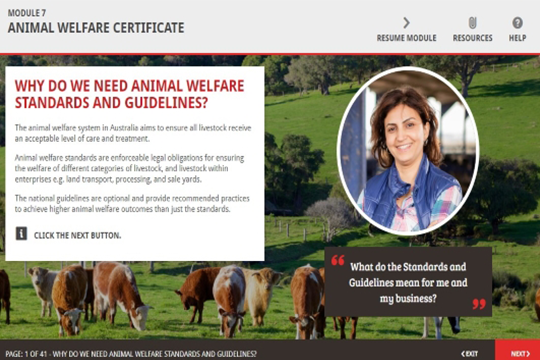
LPA Learning
Consolidate your knowledge on Animal Welfare by completing this LPA Learning module.
The Australian red meat industry is strongly committed to ensuring the highest standards of animal welfare practices are maintained throughout the supply chain. Together with the red meat industry, MLA has implemented a range of programs and initiatives to address animal welfare concerns and ensure continuous improvement in animal welfare practices.
Livestock health and wellbeing is fundamental to the success and sustainability of every farm. Australian red meat producers are fully aware of their obligations and take their responsibilities in caring for their animals very seriously.
How do producers meet this LPA requirement?
To ensure the handling of livestock is consistent with the requirements of the Australian Animal Welfare Standards and Guidelines for cattle, sheep and goats (as applicable), livestock producers are required to:
What are the Australian Animal Welfare Standards and Guidelines?
The Australian Animal Welfare Standards and Guidelines cover producers’ responsibilities and set out animals’ needs in relation to feed and water; risk management in extreme weather, natural disasters, disease, injury and predation; facilities and equipment; handling and management/husbandry; breeding management; and humane killing.
For cattle, the Standards and Guidelines also cover castration, dehorning and spaying; calf rearing systems; dairy management; and beef feedlots. For sheep, additional chapters address tail docking and castration; mulesing; and intensive sheep production systems. The Standards and Guidelines for goats cover both dairy management and intensive goat production systems.
The Standards and Guidelines were developed to harmonise and streamline livestock welfare legislation in Australia, resulting in improved welfare in a way that is practical.
Australian livestock producers care for their animals and are committed to animal welfare practices and this livestock care is fundamental to the success and sustainability of every farm.
Australia’s red meat customers, both domestically and overseas, seek reassurance that livestock are cared for humanely and ethically.
Under LPA, on-farm systems are implemented to ensure the management of livestock is consistent with the requirements of the Australian Animal Welfare Standards and Guidelines for cattle, sheep and goats. This provides customers with the evidence that the animals have been treated ethically.
Animal welfare was included in the LPA program on 1 October 2017. LPA-accredited producers must ensure animal welfare requirements are fulfilled by following the Australia Animal Welfare Standards and Guidelines for cattle, sheep and/or goats (as applicable).

Consolidate your knowledge on Animal Welfare by completing this LPA Learning module.

Watch this video to understand how to meet the animal welfare requirements of LPA to ensure that livestock are cared for humanely and ethically.
Producer practices that contribute to improved animal welfare outcomes include:
Producers who have developed a Farm Biosecurity Plan as part of their approach to Johne’s disease management do not need to complete another plan under the LPA program requirements.
The transporter must ensure that the loading of animals into stock crates adheres to appropriate penning density recommendations to minimise welfare risks.
Loading densities are determined according to body weight but should also consider the species and class, wool or hair length, weather conditions, expected transport time, size and body condition, horn status and design and capacity of the pen/crate.
Read more in Table four on page 17 of the ‘Is the animal fit to load’ guide.